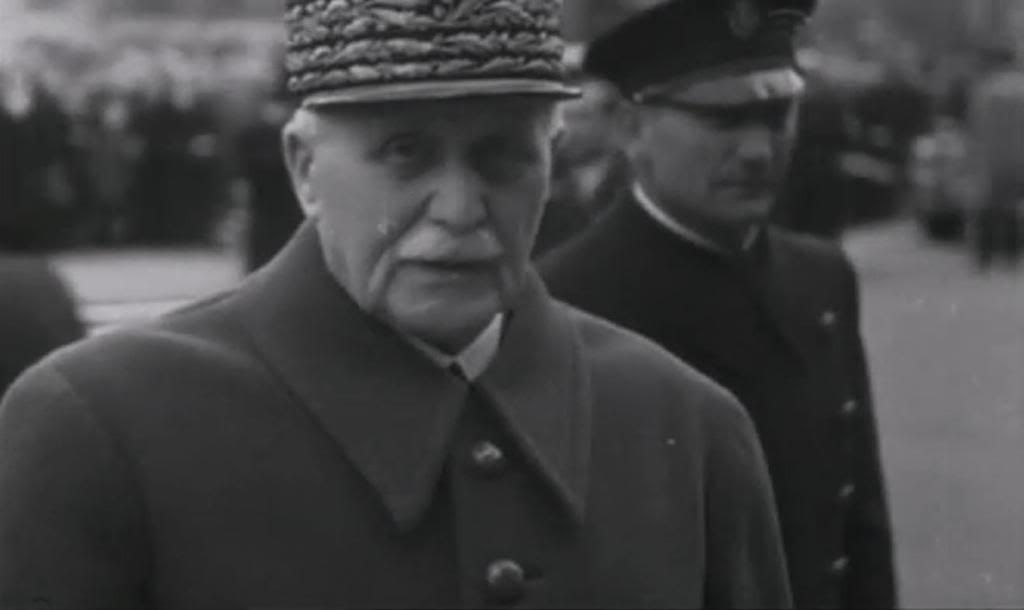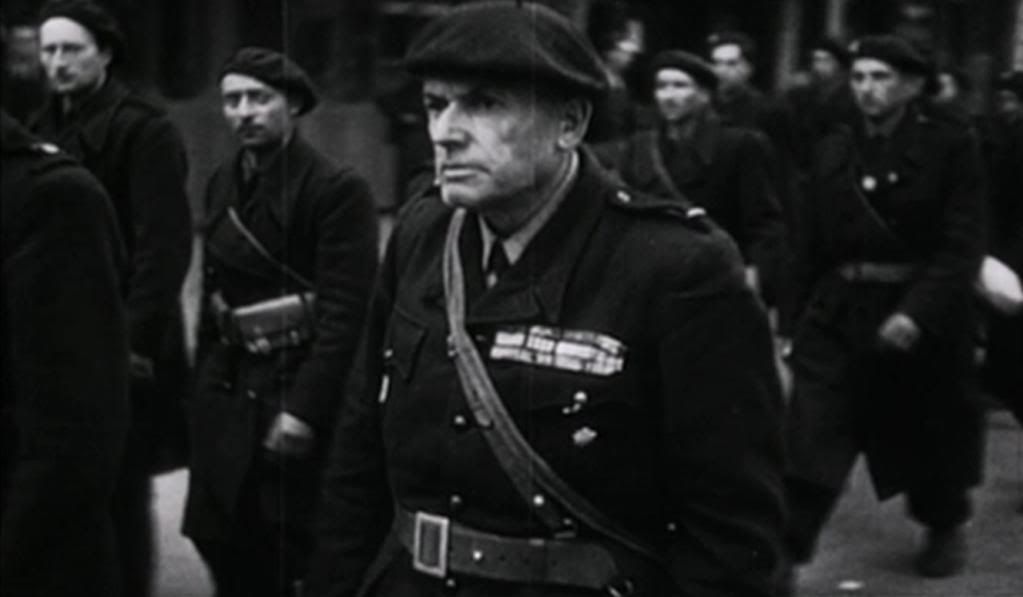

Claude Chabrol's The Eye of Vichy is a fascinating documentary that collages together newsreel footage and propaganda films from the Vichy era in France. This compilation of materials shown in French theaters between 1940 and 1944 is presented almost without comment. A narrator introduces the film with a condensed history of World War II leading up to the invasion of France and the establishment of the Vichy regime, and thereafter the narrator mostly falls silent except for providing occasional snippets of historical context. The film is thus constructed primarily from Vichy's own transmissions, the propaganda and slanted news shown to French citizens during the war. As the text at the beginning of the film says, this is France not as it actually was during this period, but as the government wished people to think it was. This is a montage of primary sources that lays bare the lies and distortions that served as a cloak for the Vichy government's sinister collaboration with the Nazis.
Much of Chabrol's fictional oeuvre is concerned with probing the pathetic absurdity and ugliness of the surface presented by bourgeois culture; his films simultaneously document the appearance and the filthy reality underneath. This documentary, otherwise so different in form and content from the rest of Chabrol's work, actually has a similar thematic focus, using the Vichy regime's self-presentation to pick at the ugly truths that are never quite obscured by the gloss of propaganda. One of Chabrol's guiding principles in his films has always been that one can tell a lot about a culture by the lies it tells (about) itself, which is why he has always been so successful in deconstructing and ridiculing bourgeois culture. Here, he turns that same incisive eye for the significance of lies on an entire government founded on lies. This seemingly straightforward presentation of those lies, with only limited overt commentary, reveals a great deal about the workings of Vichy France.
Much of the propaganda collected here is of the usual sort, idealizing and idolizing the new rulers of France — even if sometimes they're replaced, without ceremony, weeks later — and presenting rosy depictions of Franco-German harmony. One particularly twisted piece, intended to discourage French dreams of liberation, is a cartoon in which the Allies are depicted as Mickey Mouse, Popeye and Donald Duck, planning to bomb France while the British broadcast duplicitous messages of peace. Chabrol mostly lets the material stand on its own, only occasionally correcting the particularly subtle lies. The propaganda is so crude and obvious that, for the most part, no comment is needed.
At times, the propagandists can even be startlingly open about the horrors of the situation. One newsreel speaks of Resistance fighters killing two French officers, and says that 50 men have been killed in reprisal, and that 50 more will be killed tomorrow if the culprits aren't caught. It's so offhanded, so casual in the way this propaganda piece admits to mass killings — and who did they kill, exactly? Obviously, in the name of inspiring fear, the regime sometimes admitted to its own violence and repression.


Indeed, one striking feature of this footage is how often the propaganda echoes, almost subconsciously, the atrocities committed by the Nazis and their allies. The newsreels repeatedly show trains running between France and Nazi Germany, but of course these are not the trains loaded with Jewish prisoners, destined for the concentration camps. Instead, the films show trains leaving for Germany full of French unemployed people, supposedly going to Germany to work, waving goodbye with a smile as the train rolls out of the station towards the east. The trains also bring back French prisoners of war from Germany, with sentimental scenes of returning soldiers embracing their wives, childrens and dogs. In another sequence, made shortly after Germany's invasion of Russia, the French propaganda abruptly turns on the Bolsheviks with an exposé of a Soviet embassy in Paris, revealing the hidden passages and peepholes and, chillingly, some seemingly innocuous stoves that the news announcer compares, apparently without shame or irony, to crematorium ovens.
Later in the film, in one of the few overt examples of Chabrol's editorial commentary, Chabrol juxtaposes images of happy French children heading to the countryside on vacation with a dry recounting of the numbers of Jewish men, women and children arrested and shipped to camps during the same summer. The sequence continues with a documentary on the wartime gas industry in France, and another on the recycling of hair from barbershops into raw material for clothes. The narration continues to explain what the films, of course, do not, that during this period Jews were being sent en masse to Auschwitz for "immediate extermination," their bodies burnt up in ovens, their heads shaved, their possessions stripped and stolen from them before their deaths. The sequence is chilling, with the dispassionate voiceover probing the unspoken truth that Vichy hid in favor of these dry industrial documentaries, the imagery of which is nevertheless eerily resonant with the real state of things.
Another informational piece collected here celebrates the destruction of old, pre-war films to make shoe polish and nail polish, showing images of pre-war film stars melting down, piles of film stock being thrown into processing machines that turn them to muck. That disregard for celluloid must have especially galled the cinephile Chabrol, but more than that it represents an antagonistic perspective towards history and culture, a wish to erase the truths of the past and replace them with the new, manufactured history of the Nazis and Vichy. The new authoritarian regimes of the fascist block exerted complete control over the image, and any images that could not be controlled were simply destroyed. Chabrol's film is a potent and informative rejection of that ethos: rather than destroying the images of this hateful past, he assembles them into a historical record of repression and denial, incontrovertible evidence that some might like to see burnt up, recycled for consumer products. If Vichy tried to erase the past and lie about the present, this film presents these images for all to see, preserving rather than destroying the past.

2 comments:
I have not seen this Chabrol documentary, but it sounds altogether fascinating chronicle of an essential component of that terrible time. Wow those propaganda numbers are amazing. Another exceptional piece.
Dommage qu'on ne montre pas ce film de Chabrol à la télé.Chabrol fut mon sergent losque en 1954 je faisais le peloton des élèves médecins .Il était très cool ! On apralit déjà cinéma avec lui et on jouait au bridge !Je crois lui avoir parlé des films américains qu'on put voir jusqu'à la fin 1942 en zône non occupée!J'ai même vu à marseille avec un ami ( mort ensuite à Auschwitz) sur la canne bière Go West le film des ( très juifs ) Marx brothers !Amitiés MF KAHNoknote
Post a Comment